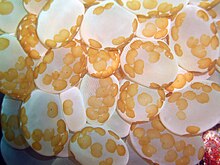| Acoela Temporal range: [1]
| |
|---|---|

| |
| Many flatworm-like, orange individuals of the Waminoa acoel on a Plerogyra coral (whitish bubbles) | |
| Scientific classification | |
| Domain: | Eukaryota |
| Kingdom: | Animalia |
| Phylum: | Xenacoelomorpha |
| Subphylum: | Acoelomorpha |
| Order: | Acoela Uljanin, 1870 |

Acoela, or the acoels, is an order of small and simple invertebrates in the subphylum Acoelomorpha of phylum Xenacoelomorpha, a deep branching bilaterian group of animals, which resemble flatworms. Historically they were treated as an order of turbellarian flatworms.[2][3] About 400 species are known, but probably many more not yet described.[4]
The etymology of "acoel" is from the Ancient Greek words ἀ (a), the alpha privative, expressing negation or absence, and κοιλία (koilía), meaning "cavity".[5][6] This refers to the fact that acoels have a structure lacking a fluid-filled body cavity.
- ^ Knaust, Dirk (2021-10-07). "A microbialite with its entombed benthic community from the Middle Triassic (Anisian-Ladinian) Muschelkalk Group of Germany". Palaeontographica Abteilung A. 320 (1–3): 1–63. doi:10.1127/pala/2021/0114. ISSN 0375-0442.
- ^ Cannon, Johanna Taylor; Vellutini, Bruno Cossermelli; Smith, Julian; Ronquist, Fredrik; Jondelius, Ulf; Hejnol, Andreas (2016). "Xenacoelomorpha is the sister group to Nephrozoa". Nature. 530 (7588): 89–93. Bibcode:2016Natur.530...89C. doi:10.1038/nature16520. ISSN 0028-0836. PMID 26842059. S2CID 205247296.
- ^ Jimenez-Guri E, Paps J, Garcia-Fernandez J, Salo E (2006), "Hox and ParaHox genes in Nemertodermatida, a basal bilaterian clade", Int. J. Dev. Biol., 50 (8): 675–9, doi:10.1387/ijdb.062167ej, PMID 17051477.
- ^ A New Species of Acoela Possessing a Middorsal Appendage with a Possible Sensory Function
- ^ Bailly, Anatole (1981-01-01). Abrégé du dictionnaire grec français. Paris: Hachette. ISBN 2010035283. OCLC 461974285.
- ^ Bailly, Anatole. "Greek-french dictionary online". www.tabularium.be. Retrieved 2020-03-02.